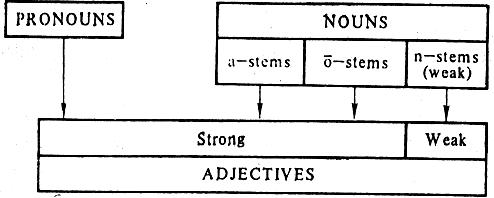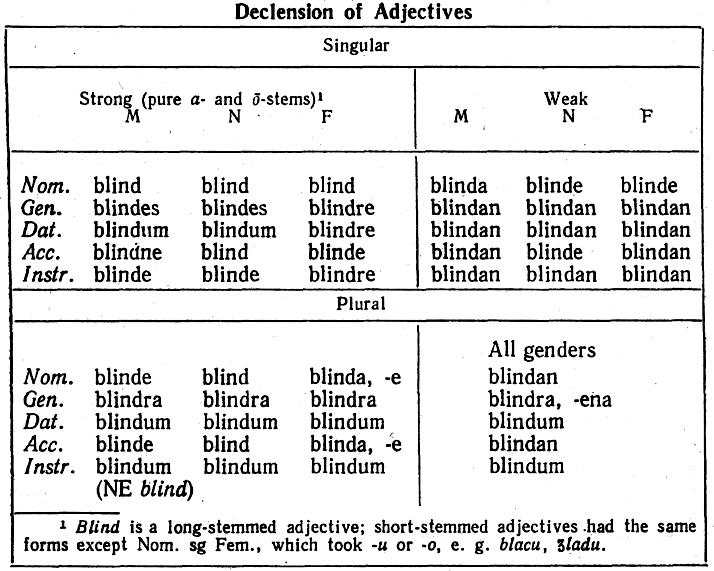
- •Lecture 8 old english grammar Plan
- •Literature
- •Preliminary remarks. Form-Building. Parts of Speech and Grammatical Categories
- •The noun Grammatical Categories. The Use of Cases
- •Morphological Classification of Nouns. Declensions
- •The pronoun
- •Personal Pronouns
- •Other Classes of Pronouns
- •The adjective Grammatical Categories
- •Weak and Strong Declension
- •Degrees of Comparison
- •The verb
- •Grammatical Categories of the Finite Verb
- •Grammatical Categories of the Verbals
- •Morphological Classification of Verbs
- •Strong Verbs
- •Weak Verbs
- •Minor Groups of Verbs
- •The Phrase. Noun, Adjective and Verb Patterns
- •Compound and Complex Sentences. Connectives
- •Word Order
Other Classes of Pronouns
Interrogative pronouns – hwā, Masc. and Fem., and hw et, Neut., – had a four-case paradigm (NE who, what). The Instr. case of hw et was used as a separate interrogative word hwy (NE why). Some interrogative pronouns were used as adjective pronouns, e.g. hwelc, hw eper.
Indefinite pronouns were a numerous class embracing several simple pronouns and a large number of compounds: an and its derivative eni (NE one, any); nan, made up of an and the negative particle ne (NE none); nanpin , made up of the preceding and the noun ping (NE nothing); nawiht/nowiht/noht (‘nothing’, NE not), hw et-hwu u ‘something’ and many others.
Pronouns of different classes – personal and demonstrative – could be used in a relative function, as connectives. The demonstrative se in its various forms and the personal pronoun he, either alone or together with a special relative particle pe could join attributive clauses,
e.g.: Se pe me eh elde se cw eð to me ‘he who healed me, he said to me’
The adjective Grammatical Categories
As stated before, the adjective in OE could change for number, gender and case. Those were dependent grammatical categories or forms of agreement of the adjective with the noun it modified or with the subject of the sentence – if the adjective was a predicative. Like nouns, adjectives had three genders and two numbers. The category of case in adjectives differed from that of nouns: in addition to the four cases of nouns they had one more case, Instr. It was used when the adjective served as an attribute to a noun in the Dat. case expressing an instrumental meaning – e. g.:
lytle werede 'with (the help of) a small troop'.
Weak and Strong Declension
As in other OG languages, most adjectives in OE could be declined in two ways: according to the weak and to the strong declension. The formal differences between the declensions, as well as their origin, were similar to those of the noun declensions. The strong and weak declensions arose due to the use of several stem-forming suffixes in PG: vocalic a-, o-, u- and i- and consonantal n-. Accordingly, there developed sets of endings of the strong declension mainly coinciding with the endings of a-stems of nouns for adjectives in the Masc., and Neut. and of o-stems – in the Fem., with some differences between long- and short-stemmed adjectives, variants with -j- and -w-, monosyllabic and polysyllabic adjectives and some remnants of other stems. Some endings in the strong declension of adjectives have no parallels in the noun paradigms; they are similar to the endings of pronouns: -um for Dat. sg, -ne for Acc. sg Masc., [r] in some Fem. and pl endings. Therefore the strong declension of adjectives is sometimes called the "pronominal" declension. As for the weak declension, it uses the same markers as n-stems of nouns except that in the Gen. pl the pronominal ending -ra is often used instead of the weak -ena (see the paradigms in Table 7).
The relations between the declensions of nouns, adjectives and pronouns are shown in the following chart:

The difference between the strong and the weak declension of adjectives was not only formal but also semantic. Unlike a noun, an adjective did not belong to a certain type of declension. Most adjectives could be declined in both ways. The choice of the declension was determined by a number of factors: the syntactical function of the adjective, the degree of comparison and the presence of noun determiners. The adjective had a strong form when used predicatively and when used attributively without any determiners, e.g.:
![]()
The weak form was employed when the adjective was preceded by a demonstrative pronoun or the Gen. case of personal pronouns, e. g.:
Table 7

![]()
and also when the adjective formed a part of a direct address:
![]()
Some adjectives, however, did not conform with these rules: a few adjectives were always declined strong, e. g. eall, mani , oper (NE a, many, other), while several others were always weak: adjectives in the superlative and comparative degrees, ordinal numerals, the adjective ilca ‘same’. Despite these instances of fixed, unmotivated usage, there existed a certain semantic contrast between the strong and weak forms: the strong forms were associated with the meaning of indefiniteness (roughly corresponding to the meaning of the modern indefinite article), the weak forms – with the meaning of "definiteness" (corresponding to the meaning of the definite article). Therefore the weak forms were regularly used together with demonstrative pronouns. The formal and semantic opposition between the two declensions of adjectives is regarded by some historians as a grammatical category which can be named "the category of definiteness/indefiniteness" (A.I. Smirnitsky).
It follows that potentially OE adjectives could distinguish up to sixty forms. In reality they distinguished only eleven. Homonymy of forms in the adjective paradigms was three times as high as in the noun. It affected the grammatical categories of the adjective to a varying degree.
Neutralisation of formal oppositions reached the highest level in the category of gender: gender distinctions were practically non-existent in the pl, they were lost in most cases of the weak declension in the sg; in the strong declension Neut. and Masc. forms of adjectives were almost alike.
Formal distinction of number, case and the strong and weak forms was more consistent. As seen from Table 7, number and case were well distinguished in the strong declension, with only a few instances of neutralisation; the distinction of number was lost only in the Dat. case, Masc. and Neut. Cf.:

The forms in the weak declension were less distinctive, as thirteen forms out of twenty ended in -an.
The formal difference between strong and weak forms was shown in all cases and both numbers, the only homonymous forms being Dat. pl and Gen. pl, – if it took the ending -ra.
In later OE the distinction of forms in the adjective paradigm became even more blurred, the Instr. case fell together with the Dat. Numerous variant forms with phonetically reduced endings or with markers borrowed from other forms through analogy impaired the distinction of categorial forms.
